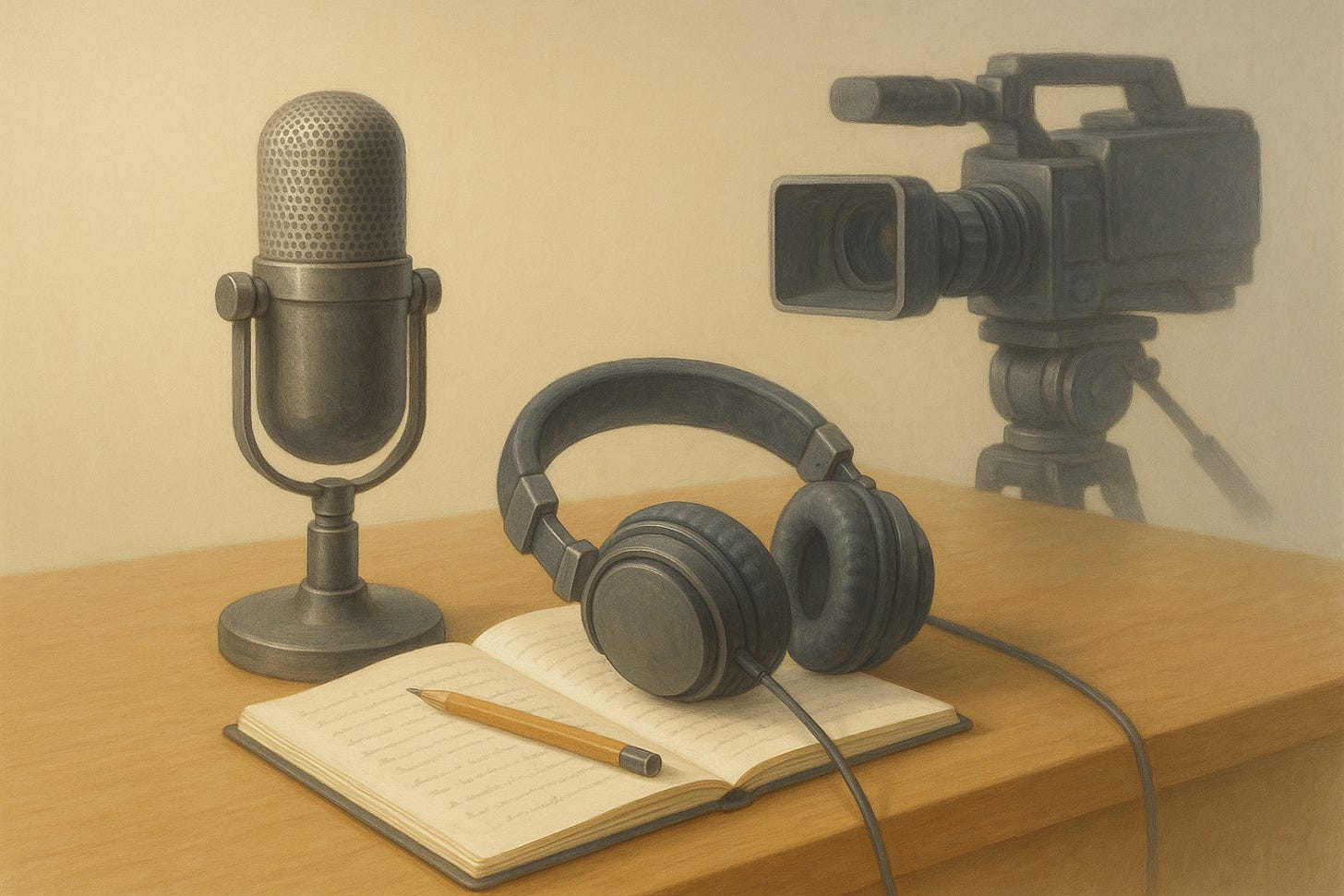I was listening to a podcast the other day—properly listening, with my eyes closed, letting the voices wash over me like a warm bath of human connection—when I made the mistake of checking the YouTube comments. "Why doesn't Sarah look at Mike when she's talking?" one viewer had written. "Mike's facial expressions are SO cringe," said another. And there it was: the death of everything beautiful about podcasts, laid bare in 240 characters or fewer.
You see, somewhere along the way, we've committed the most heinous crime against audio entertainment since someone decided to add a laugh track to The Big Bang Theory. We've ruined podcasts by making them visual. And I'm here to tell you that this is not progress—it's vandalism of the highest order.
Podcasts were supposed to be radio's revenge. After decades of television making everything about hair and teeth and whether your interviewer has remembered to wear trousers, along came this beautiful medium that said: "Forget all that nonsense. Just talk. Just be." It was democracy in audio form. The spotty teenager with social anxiety could command the same attention as the polished BBC presenter, provided they had something interesting to say. Revolutionary.
But then someone—and I imagine it was someone wearing expensive trainers and using "content" as a verb—decided that wasn't enough. "What if," they probably said in a meeting room that smelled of overpriced coffee and broken dreams, "we could see them too?" And thus began the great podcasting betrayal of our time.
The thing is, when you can see someone's face, everything changes. Suddenly, you're not listening to a disembodied voice sharing their innermost thoughts about serial killers or sourdough starters. You're watching someone try to look interested whilst fighting the urge to check their phone, or attempting to maintain eye contact with a co-host who's clearly thinking about lunch. The magic—that beautiful, intimate magic of pure audio—evaporates faster than morning mist.
I discovered this myself during a brief, ill-advised flirtation with video podcasting. There I was, trying to discuss the psychological implications of true crime entertainment, when I caught sight of myself in the monitor. My face, it turns out, does this thing when I'm concentrating—a sort of constipated owl expression that suggests I'm either having profound thoughts or experiencing mild digestive distress. Suddenly, instead of focusing on whether Serial had fundamentally changed how we consume real-life tragedy, I was obsessing over whether my left eyebrow was higher than my right.
This is the curse of visibility. Audio-only podcasts grant us the greatest gift of all: the freedom to be genuinely ourselves without the performance anxiety that comes with being perceived. When you know someone can see you, you become an actor in the theatre of your own conversation. You start thinking about your "good side" and whether you should nod more enthusiastically when your guest makes a point about cryptocurrency.
But there's something deeper at play here, something almost philosophical. Audio-only podcasts respect the fundamental privacy of thought. When I listen to someone speak without seeing them, I create my own version of them in my mind. They become more human, not less. I'm not distracted by their choice of jumper or the fact that they keep touching their hair. I'm engaged with the pure essence of their ideas, their personality distilled into voice alone.
The great podcasters understand this. They paint pictures with words, knowing their audience is creating the visuals. They describe not just what happened, but how it felt, what it looked like, the quality of light in the room. They become storytellers in the truest sense, trusting their listeners to be co-creators in the experience.
Video podcasts, by contrast, are just radio with commitment issues. They're television that can't quite commit to being television, radio that's embarrassed to be radio. They exist in this awkward middle ground where nothing quite works. The audio isn't pure anymore because the hosts are performing for cameras. The video isn't compelling because, let's be honest, watching two people sit at microphones isn't exactly Citizen Kane.
And yet, here we are, in 2025, living through what I can only describe as the great flattening of podcasts. Everything must be content now, everything must be optimised for multiple platforms, everything must be "more engaging." But sometimes—and hear me out here—more isn't more. Sometimes more is just more, and what we actually needed was less.
So I'm making a plea: let's return to the garden of audio Eden. Let's remember that the most intimate conversations happen in darkness, that the best stories are told around fires we can't see. Let's trust that voices, unadorned and unperformed, are enough.
Because when everything else is stripped away—the lighting, the camera angles, the desperate performance of being seen—what remains is the thing that made podcasts magical in the first place: just human beings, talking to each other, as if the rest of the world had disappeared.


